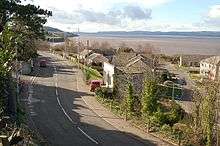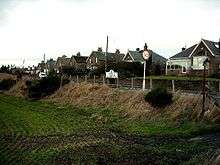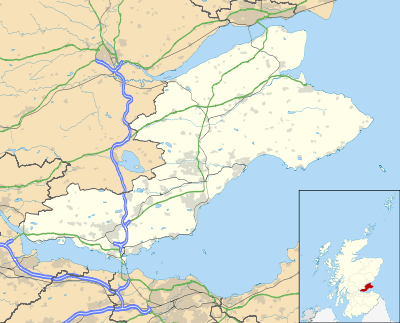Wormit
Wormit is a village on the banks of the Firth of Tay in north-east Fife, Scotland. Its location at the southern end of the Tay Rail Bridge has led to it becoming a commuter suburb of Dundee. Together with Woodhaven and Newport-on-Tay, Wormit is a part of The Burgh of Newport-on-Tay. The name of the village is thought to be derived from the plant wormwood.[1][2]


| Wormit | |
|---|---|
 Eastern part of Wormit seen from the Tay Rail Bridge | |
 Wormit Location within Fife | |
| OS grid reference | NO3624 |
| • Edinburgh | 33 mi (53 km) |
| • London | 359 mi (578 km) |
| Council area | |
| Country | Scotland |
| Sovereign state | United Kingdom |
| Post town | Newport-on-Tay |
| Postcode district | DD6 |
| Dialling code | 01382 |
| Police | Scotland |
| Fire | Scottish |
| Ambulance | Scottish |
| UK Parliament | |
| Scottish Parliament | |
Wormit Station
Wormit Railway Station opened 1 May 1889[3] and closed on 5 May 1969,[4] was operated on a closed branch line, The Newport Railway, which left the main line (Edinburgh/Dundee) railway immediately at the south end of the Bridge to serve Wormit/Newport. After closure, Wormit Station was later dismantled and rebuilt at the heritage Bo'ness & Kinneil Railway to the west of Edinburgh.
In 1955, there was a serious train crash in Wormit Station in which three people were killed and forty-one were injured.[5]
Power
Wormit claims to be the first Scottish village to have installed electricity.[6][7] A windmill located on Wormit Hill generated the power, with a steam engine supplementing this when the wind was low. This was later replaced by a coal-gas engine until the 1930s, when Wormit was connected to the national grid. Alexander Stewart, who built many of Wormit's early houses, owned the windmill and steam engine[8] and offered electrical lighting to homeowners as well as basic street lighting. Consumers paid 10 shillings a quarter and could use as much electricity as they liked. The first houses to have electricity had sun rays painted on the front, and these can still be seen along the highest row of terraced housing in the village.
Norwegian connection
During the Second World War, King Haakon VII of Norway visited a house in Wormit used as a base by officers of the Norwegian Army. The soldiers painted a sea motif for the king on the walls of a bedroom, and it is still present in the house.[9] Norwegian Catalina flying boats were stationed at Woodhaven, and a Norwegian flag is still flown in the harbour, which has since been changed back into Wormit Boating Club, from where occasional pleasure sailings operate for much of the year upon the River Tay, mainly between the Tay Rail Bridge and Tay Road Bridge.
Reservoir
Wormit water reservoir was built in 1923 in anticipation of the population of the town growing, but war intervened and the reservoir was eventually decommissioned due to costs.[10] Trevor Cox, a professor of acoustic engineering at the University of Salford, identified the reservoir as one of the "strangest sounding places in the UK". It is a large concrete box 60 m (200 ft) long, 30 m (100 ft) wide and 5 m (16 ft) high. In a normal room, sounds die away quickly due to sound waves reflecting in to the walls, losing energy. In Wormit water reservoir, the size of the room means the time between reflections is much greater, coupled with sound waves losing less energy when reflecting off concrete, meaning sounds last for much longer. This was demonstrated by an experiment in which a balloon was popped inside the reservoir.[11]
Amenities and services
Wormit has its own primary school (established in 1896),[12] church, blacksmith, garage, post office, hair dresser and local shop. The local secondary school is Madras College, St Andrews.
There are several sports clubs within Wormit, including tennis, bowling and boating clubs. Wormit Bowling Club was established in 1901; its clubhouse was built in 1955.[12]
Notable residents
- Richard Gadd, comedian
- John Meadows Jackson, FRSE (1907–1998), mathematician and physicist, lived here in the 1940s and 50s.
- Thomas Symington Halliday, MBE, FRSA (1902–1998), artist and sculptor, lived in Wormit for many years.
References
- MacKay, George (2003). Scottish Place Names. New Lanark: Geddes and Grosset. p. 96.
- "Fife Place-name Data :: Wormit". fife-placenames.glasgow.ac.uk.
- "Wormit, Naughton Road, Station – Canmore". canmore.rcahms.gov.uk.
- Holland, Julian (2013). Dr Beeching's Axe 50 Tears on: Memories of Britain's Lost Railways. David & Charles. ISBN 9781446302675.
- "Report on the Derailment which occurred on 28th May 1955 at Wormit in the Scottish Region British Railways". Retrieved 9 June 2013.
- "Wormit – VisitScotland". Retrieved 9 June 2013.
- "Overview of Wormit". Retrieved 9 June 2013.
- "Riverside Road, Wormit – Photopolis". Retrieved 9 June 2013.
- "PressReader.com – Your favorite newspapers and magazines". www.pressreader.com.
- "The UK's five weirdest sounding places". 29 December 2012. Retrieved 6 June 2018 – via www.bbc.co.uk.
- "The strange sound of Wormit water reservoir". 19 December 2012. Retrieved 6 June 2018 – via www.bbc.co.uk.
- Spotlight on Wormit, The Courier, 18 May 2020, p. 30